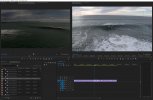- Joined
- Dec 10, 2020
- Messages
- 2
- Reaction score
- 3
- Age
- 41
Hello,
I'm new to the Inspire 2 and am having to learn all the codec & container information from scratch.
I filmed a few scenes in CinemaDNG with the X5S and am loving the output, but it's pretty confusing and I'm not sure of the exact settings or workflow for Premiere. Is it really this hard?
What are you all doing for CinemaDNG workflow? Specifically when ingesting & editing in Premiere?
Thank you in advance!
I'm new to the Inspire 2 and am having to learn all the codec & container information from scratch.
I filmed a few scenes in CinemaDNG with the X5S and am loving the output, but it's pretty confusing and I'm not sure of the exact settings or workflow for Premiere. Is it really this hard?
What are you all doing for CinemaDNG workflow? Specifically when ingesting & editing in Premiere?
Thank you in advance!







